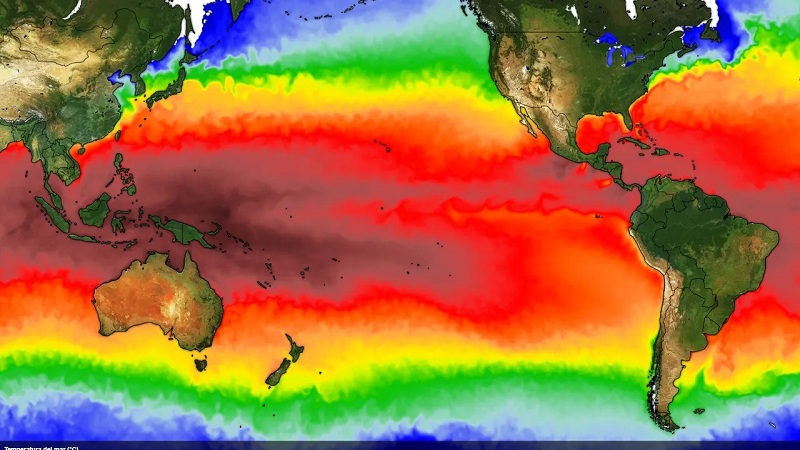
“La Niña has come to an end,” the National Meteorological Service announced this Wednesday, alluding to the oceanic phenomenon that is associated with the prolonged drought that we are experiencing in the country. In any case, the rains are not going to come as quickly as they indicate from the Service on Twitter.
✨THE GIRL HAS COME TO AN END!!!✨
announced today @NOAAClimate. But watch out! 👇In Argentina we are still not going to see much variation in rainfall. Despite the change in ocean temperature, the atmosphere still maintains a La Niña circulation. pic.twitter.com/LEWvtgs1tE
— SMN Argentina (@SMN_Argentina) March 9, 2023
After La Niña, El Niño is expected to happen: this is the name of two of the three phases that make up the phenomenon of change in the temperature of the Pacific Ocean (the third is a neutral phase) that we are witnessing today. The two phases, La Niña and El Niño, affect the atmosphere, and when they come into contact with it, they cause alterations in the climatic conditions in parts of the planet. La Niña is characterized by large masses of cold air that travel from Asia to America through the Pacific Ocean, so it tends to lower the temperature since the rains that occur in this phase are below normal. On the contrary, El Niño is characterized by hot air masses, which make the opposite trip, raise the temperature, and cause rains that tend to be higher than normal.
But how can it be that in the midst of a phenomenon that should lower the temperature, these heat waves occur? It is that it is profoundly altered by the action of the climate crisis. For the worse, the phase of El Niño that is arriving is the one that is associated with the increase in temperature. With which, if we are experiencing tremendous heat waves, those of next year and next summer will be even more intense. For this reason, the historical temperature records reached with La Niña are so worrying. And although this phase is now withdrawn and the temperature of the ocean would be changing, the atmosphere is still maintained with a circulation according to the previous phase, so the weather conditions did not change and therefore it does not rain.
REPORT 🟤| He #summer 2022/23 was the 3rd driest summer in Argentina for the period 1961-2023. In 1st and 2nd place were the summer seasons of 1961/62 and 1988/89. 👉29.1% less rain than normal was recorded.
In addition, AMBA and Corrientes had their driest summer. pic.twitter.com/Z7d2zcU8xl
— SMN Argentina (@SMN_Argentina) March 8, 2023
Although La Niña/El Niño is an irregular phenomenon, usually occurring every two to seven years for months, for the first time this century it occurred for three consecutive years, something that hasn’t happened since the 1960s. we are before the entry of the El Niño phase, the World Meteorological Organization announced in its official bulletin that more intense heat waves are forecast for next year, since El Niño will become more frequent and intense in the coming years and its impacts negatives will increase. This will be felt in large regions, mainly in Latin America and Asia (equatorial Pacific Ocean) impacted by global warming as a consequence of the use of fossil fuels (oil, gas and coal), changes in land use due to agribusiness, deforestation processes or the reduction of forests and wetlands due to the real estate and timber business, and the advance of the agricultural frontier on ecosystems.
The environmental impact on the fluctuation of the temperature of the oceans is incalculable and its effects are not the same for everyone. These weeks it was possible to see how the heat wave is much worse for the popular sectors, power cuts for long days in the poorest neighborhoods, sick children in several public schools due to lack of adequate ventilation, similar conditions are experienced daily in factories and other workplaces. Government responses, such as sending water bottles to some schools, seem more like a provocation than a solution.
According to the latest UN IPCC (Report of the Intergovernmental Panel on Climate Change), the extraction and exploitation of fossil fuels is taking global warming of the Earth to the limit (greenhouse effect), which is behind the profound alteration of the phenomenon. La Niña/El Niño and at the base the unbearable heat wave. Globally, there are no concrete measures to deal with the climate crisis and the commitments of “targets to reduce carbon emissions” are empty paper.
In Argentina, the government of Alberto and Cristina Fernández deepens the exploitation of hydrocarbons and extractivism, which increases the problem of complying with the IMF. While they encourage fracking in Vaca Muerta and offshore at the hands of the big oil monopolies, responsible for huge environmental disasters, they continue to drive record deforestation/destruction of record sinks or carbon depleters. Today Argentina is in the world top ten in this anti-ecological “field”.
No, it’s not just summer. They are the direct consequences of a social system that commodifies nature and is pushing it to the limit. As the youth mobilizing around the world say, “let’s change the system, not the climate”. We need a way out and a force that considers advancing in a true energy transition, built from below, from the workers and the popular sectors that suffer the consequences of the actions of a powerful few that generate the enormous climate crisis. The PTS in the Unity Left Front has been insisting on this path.
Source: www.laizquierdadiario.com

